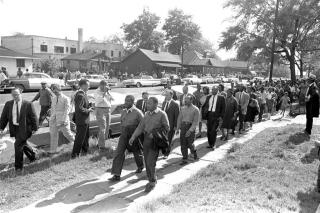Today in History: April 16, Martin Luther King Jr. writes ‘Letter From Birmingham Jail’

In this file photo taken April 12, 1963 Rev. Ralph Abernathy, left, and Rev. Martin Luther King Jr. lead a column of demonstrators as they attempt to march on Birmingham, Ala., City Hall. Arrested for leading a march against racial segregation in 1963, King Jr. spent days in solitary confinement writing his “Letter From Birmingham Jail,” which was smuggled out and stirred the world by explaining why Black people couldn’t keep waiting for fair treatment. (AP Photo/Horace Cort)
Today in History:
On April 16, 1963, Martin Luther King Jr. wrote his “Letter from Birmingham Jail” in which the civil rights activist responded to a group of local clergymen who had criticized him for leading street protests; King defended his tactics, writing, “Injustice anywhere is a threat to justice everywhere.”
On this date:
In 1789, President-elect George Washington left Mount Vernon, Virginia, for his inauguration in New York.
In 1889, comedian and movie director Charles Chaplin was born in London.
In 1945, a Soviet submarine in the Baltic Sea torpedoed and sank the ship the MV Goya, which Germany was using to transport civilian refugees and wounded soldiers; it’s estimated that up to 7,000 people died.
In 1947, the cargo ship Grandcamp, carrying ammonium nitrate, blew up in the harbor in Texas City, Texas; a nearby ship, the High Flyer, which was carrying ammonium nitrate and sulfur, caught fire and exploded the following day; the blasts and fires killed nearly 600 people.
In 1972, Apollo 16 blasted off on a voyage to the moon with astronauts John W. Young, Charles M. Duke Jr. and Ken Mattingly on board.
In 1977, Alex Haley, author of the best-seller “Roots,” visited the Gambian village of Juffure, where, he believed, his ancestor Kunte Kinte was captured as a slave in 1767.
In 1996, Britain’s Prince Andrew and his wife, Sarah, the Duchess of York, announced they were in the process of divorcing.
In 2003, Michael Jordan played his last NBA game with the Washington Wizards, who lost to the Philadelphia 76ers, 107-87.
In 2007, in one of America’s worst school attacks, a college senior killed 32 people on the campus of Virginia Tech before taking his own life.
In 2010, the U.S government accused Wall Street’s most powerful firm of fraud, saying Goldman Sachs & Co. had sold mortgage investments without telling buyers the securities were crafted with input from a client who was betting on them to fail. (In July 2010, Goldman agreed to pay $550 million in a settlement with the Securities and Exchange Commission, but did not admit wrongdoing.)
In 2012, a trial began in Oslo, Norway, for Anders Breivik (AHN’-durs BRAY’-vihk), charged with killing 77 people in a bomb and gun rampage in July 2011. (Breivik was found guilty of terrorism and premeditated murder and given a 21-year prison sentence.)
In 2013, NFL player-turned-broadcaster Pat Summerall, died in Dallas at age 82.
In 2018, the New York Times and The New Yorker won the Pulitzer Prize for public service for breaking the Harvey Weinstein scandal with reporting that galvanized the #MeToo movement.
In 2020, the Trump administration gutted an Obama-era rule that compelled the country’s coal plants to cut back emissions of mercury and other human health hazards.
In 2021, Jon Ryan Schaffer, a member of the far-right Oath Keepers militia group and a heavy metal guitarist, became the first defendant to plead guilty to federal charges in connection with the Jan. 6 insurrection at the U.S. Capitol.
In 2022, Russian forces accelerated scattered attacks on Kyiv, western Ukraine and beyond, a sign that the entire country was still under assault despite Russia’s pivot toward mounting a new offensive in the east.
